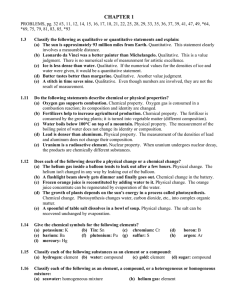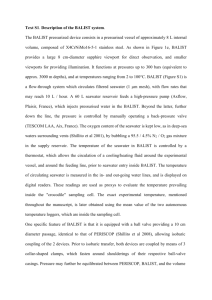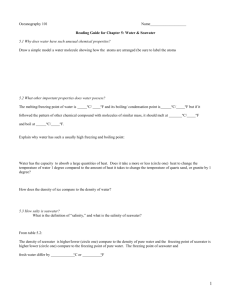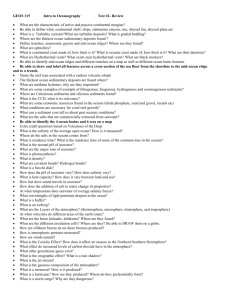Ch. 1
advertisement
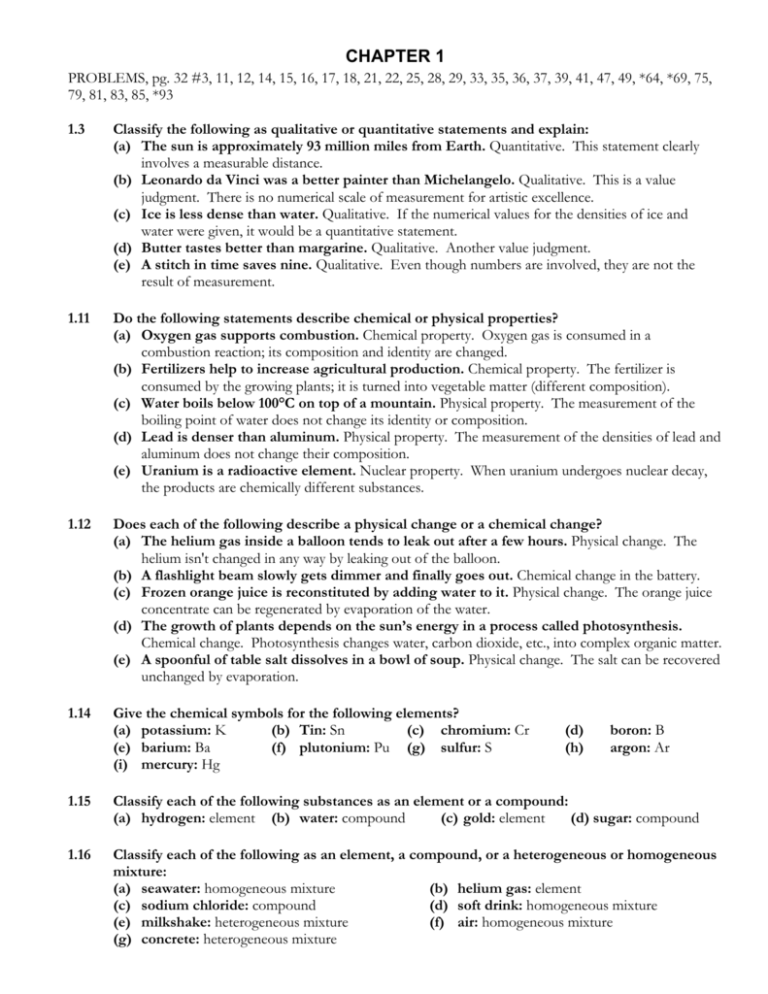
CHAPTER 1 PROBLEMS, pg. 32 #3, 11, 12, 14, 15, 16, 17, 18, 21, 22, 25, 28, 29, 33, 35, 36, 37, 39, 41, 47, 49, *64, *69, 75, 79, 81, 83, 85, *93 1.3 Classify the following as qualitative or quantitative statements and explain: (a) The sun is approximately 93 million miles from Earth. Quantitative. This statement clearly involves a measurable distance. (b) Leonardo da Vinci was a better painter than Michelangelo. Qualitative. This is a value judgment. There is no numerical scale of measurement for artistic excellence. (c) Ice is less dense than water. Qualitative. If the numerical values for the densities of ice and water were given, it would be a quantitative statement. (d) Butter tastes better than margarine. Qualitative. Another value judgment. (e) A stitch in time saves nine. Qualitative. Even though numbers are involved, they are not the result of measurement. 1.11 Do the following statements describe chemical or physical properties? (a) Oxygen gas supports combustion. Chemical property. Oxygen gas is consumed in a combustion reaction; its composition and identity are changed. (b) Fertilizers help to increase agricultural production. Chemical property. The fertilizer is consumed by the growing plants; it is turned into vegetable matter (different composition). (c) Water boils below 100°C on top of a mountain. Physical property. The measurement of the boiling point of water does not change its identity or composition. (d) Lead is denser than aluminum. Physical property. The measurement of the densities of lead and aluminum does not change their composition. (e) Uranium is a radioactive element. Nuclear property. When uranium undergoes nuclear decay, the products are chemically different substances. 1.12 Does each of the following describe a physical change or a chemical change? (a) The helium gas inside a balloon tends to leak out after a few hours. Physical change. The helium isn't changed in any way by leaking out of the balloon. (b) A flashlight beam slowly gets dimmer and finally goes out. Chemical change in the battery. (c) Frozen orange juice is reconstituted by adding water to it. Physical change. The orange juice concentrate can be regenerated by evaporation of the water. (d) The growth of plants depends on the sun’s energy in a process called photosynthesis. Chemical change. Photosynthesis changes water, carbon dioxide, etc., into complex organic matter. (e) A spoonful of table salt dissolves in a bowl of soup. Physical change. The salt can be recovered unchanged by evaporation. 1.14 Give the chemical symbols for the following elements? (a) potassium: K (b) Tin: Sn (c) chromium: Cr (e) barium: Ba (f) plutonium: Pu (g) sulfur: S (i) mercury: Hg 1.15 Classify each of the following substances as an element or a compound: (a) hydrogen: element (b) water: compound (c) gold: element (d) sugar: compound 1.16 Classify each of the following as an element, a compound, or a heterogeneous or homogeneous mixture: (a) seawater: homogeneous mixture (b) helium gas: element (c) sodium chloride: compound (d) soft drink: homogeneous mixture (e) milkshake: heterogeneous mixture (f) air: homogeneous mixture (g) concrete: heterogeneous mixture (d) (h) boron: B argon: Ar 2 SUMMER ASSINGMENT ANSWER KEY: CHAPTER 1 1.17 Name the SI base units that are important in chemistry. Give the SI units for expressing the following: (a) length: meter (b) volume: liter (c) mass: kilogram (d) time: second (e) energy: Joule (f) temperature: Kelvin 1.18 Write the numbers represented by the following prefixes: (a) mega: 106 (b) kilo: 103 (c) deci: 10–1 –2 –3 (d) centi: 10 (e) milli: 10 (f) micro (µ): 10–6 –9 –12 (g) nano: 10 (h) pico: 10 1.21 density = mass so mass = density × volume volume 0.798 g mass of ethanol = × 17.4 mL = 13.9 g 1 mL density = 1.22 1.25 586 g mass = = 3.12 g / mL volume 188 mL 1K 1°C (a) K = 113°C + 273°C = 386 K (b) K = 37°C + 273°C = 3.10 × 102 K (c) K = 357°C + 273°C = 6.30 × 102 K K = ( °C + 273°C ) 1.28 A significant figure is one that can be certain or reasonably certain to be correct. In measurements, significant figures indicate the precision of the equipment: all certain digits plus a final estimate, or one more digit than given by the markings. Use of proper significant figures is important to convey the precision of one’s measurements and/or calculations. 1.29 Express the following in scientific notation: (a) 0.000 000 27: 2.7 × 10–8 (b) 356: 3.56 × 102 (c) 47,764: 4.7764 × 104 (d) 0.096: 9.6 × 10–2 1.33 What is the number of significant figures in each of the following measurements? (a) 4867 mi: four (b) 56 mL: two (c) 60,104 ton: five (d) 2900 g: two, three, or four 3 (e) 40.2 g/cm : three(f) 0.0000003 cm: one (g) 0.7 min: one (h) 4.6×1019 atoms: two 1.35 (a) 5.6792 m + 0.6 m + 4.33 m = 10.6 m (b) 3.70 g – 2.9133 g = 0.79 g (c) 4.51 cm × 3.6666 cm =16.5 cm2 1.36 (a) (b) 7.310 km = 1.283 5.70 km → 1.28 0.00326 mg − 0.0000788 mg 0.0031812 mg 5.6792 m 0.6 m 4.33 m 10.6092 m (Why are there no units?) 0.00318 mg = 3.18 × 10–3 mg SUMMER ASSINGMENT ANSWER KEY: CHAPTER 1 (c) 1.37 (0.402 × 107 dm) + (7.74 × 107 dm) = 8.14 × 107 dm (a) ? dm = 22.6 m × 1 dm = 226 dm 0.1 m −3 1 × 10 g 1 kg −5 × = 2.54 × 10 kg 1 mg 1000 g −3 1 × 10 L (c) ? L = 556 mL × = 0.556 L 1 mL (b) ? kg = 25.4 mg × 3 1.39 10.6 kg 1000 g ⎛ 1 × 10−2 m ⎞ g 3 (d) ? = × ×⎜ ⎟ = 0.0106 g / cm 3 3 1 kg cm 1m ⎝ 1 cm ⎠ 1255 m 1 mi 3600 s × × = 2808 mi / h 1s 1609 m 1h 1.41 (93 × 106 mi) × 1.47 (a) 1.42 yr × (b) 32.4 yd × 1.609 km 1000 m 1s 1 min × × × = 8.3 min 8 1 mi 1 km 60 s 3.00 × 10 m 365 day 1 yr × 24 h 3600 s 3.00 × 108 m 1 mi 12 × × × = 8.35 × 10 mi 1 day 1h 1s 1609 m 36 in 2.54 cm × = 2.96 × 103 cm 1 yd 1 in 3.0 × 10 cm 1 in 1 ft 8 × × = 9.8 × 10 ft / s 1s 2.54 cm 12 in 10 (c) 3 1.49 1.64 ⎛ 1 cm ⎞ 2.70 g 1 kg 3 3 density = × ×⎜ ⎟ = 2.70 × 10 kg / m 3 1000 g ⎝ 0.01 m ⎠ 1 cm Vanillin is the substance whose aroma the human nose detects in the smallest amount. The threshold limit is 2.0 x 10−11 g per L of air. If the current price of 50g of vanillin is $112, determine the cost to supply enough vanillin so that the aroma could be detected in a large aircraft hangar with a volume of 5.0 x 107 ft3. To work this problem, we need to convert from cubic feet to L. Some tables will have a conversion factor of 28.3 L = 1 ft3, but we can also calculate it using the factor-label method described in Section 1.9 of the text. First, convert from cubic feet to liters: 3 3 ⎛ 12 in ⎞ ⎛ 2.54 cm ⎞ 1 mL 1 × 10 −3 L 9 5.0 × 10 ft × ⎜ × = 1.4 × 10 L ⎟ ×⎜ ⎟ × 3 1 mL ⎝ 1 ft ⎠ ⎝ 1 in ⎠ 1 cm 7 3 Use the density to convert to mass of vanillin: 3 4 SUMMER ASSINGMENT ANSWER KEY: CHAPTER 1 1.4 × 10 L × 9 The cost is: 1.69 2.0 × 10 −11 g vanillin −2 = 2.8 × 10 g vanillin 1L 2.8 × 10 −2 g vanillin × $112 = $0.063 = 6.3¢ 50 g vanillin The total volume of seawater is 1.5 x 1021 L. Assume that seawater contains 3.1% sodium chloride by mass and that its density is 1.03 g/mL. Calculate the total mass of sodium chloride in kilograms and in tons. (1 ton = 2000 lbs ; 1 lbs = 453.6 b) The mass of the seawater is: 1.5 × 10 21 L × 1 mL 1.03 g × = 1.5 × 10 24 g = 1.5 × 10 21 kg seawater 0.001 L 1 mL Seawater is 3.1% NaCl by mass. The total mass of NaCl in kilograms is: mass NaCl (kg) = 1.5 × 10 21 kg seawater × mass NaCl (tons) = 4.7 × 1019 kg × 3.1% NaCl = 4.7 × 1019 kg NaCl 100% seawater 2.205 lb 1 ton × = 5.2 × 1016 tons NaCl 1 kg 2000 lb |0.798 g/mL − 0.802 g/mL| × 100% = 0.5% ; 0.798 g/mL |0.864 g − 0.837 g| (b) × 100% = 3.1% 0.864 g 1.75 (a) 1.79 Chalcopyrite, the principal are of copper (Cu) , contains 34.63 percent Cu by mass. How many grams of Cu can be obtained from 5.11 x 103 kg of the ore? ? g Cu = 5.11 × 103 kg ore × 1.81 34.63% Cu 1000 g × = 1.77 × 106 g Cu 100% ore 1 kg A 1.0 mL volume of seawater contains about 4.0 x 10-12 g of gold. The total volume of ocean water is 1.5 x 1021 L. Calculate the total amount of gold (in grams) that is present in seawater, and the worth of the gold in dollars (See problem 1.80). With so much gold out thre, why hasn’t someone become rich by mining gold from the ocean? −12 1 mL 4.0 × 10 g Au 21 12 ? g Au = 1.5 × 10 L seawater × × = 6.0 × 10 g Au 0.001 L 1 mL seawater value of gold = 6.0 × 1012 g Au × 1 lb 16 oz $350 × × = $7.4 × 1013 453.6 g 1 lb 1 oz No one has become rich mining gold from the ocean, because the cost of recovering the gold would outweigh the price of the gold. 1.83 The thin outer layer of Earth, called the crust, contains only 0.50 percent of Earth’s total mass andyet is the source of almost all the element (the atmosphere provides elements such as oxygen, nitrogen and a few other gases) Silicon (Si) is the second most abundant eleet in SUMMER ASSINGMENT ANSWER KEY: CHAPTER 1 5 Earth’s crust (27.2 percent by mass). Calculate the mass of silicon in kilograms in Earth’s crust. (The mass of Earth is 5.9 x 1021 tons. 1 ton = 2000 lbs; 1 lb = 453.6 g) 0.50% crust mass of Earth’s crust = 5.9 × 1021 tons × = 3.0 × 1019 tons 100% Earth mass of silicon in crust = 3.0 × 1019 tons crust × 27.2% Si 2000 lb 1 kg × × = 7.4 × 1021 kg Si 100% crust 1 ton 2.205 lb 1.85 One gallon of gasoline in an automobile’s engine produces on the average 9.5 kg of carbon dioxide, which is a greenhouse gas, that is, it promotes the warming of Earth’s atmosphere. Calculate the annual production of carbon dioxide in kilograms if there are 40 million cars in the United States and each car covers a distance of 5000 mi at a consumption rate of 20 miles per gallon. 5000 mi 1 gal gas 9.5 kg CO2 40 × 106 cars × × × = 9.5 × 1010 kg CO 2 1 car 20 mi 1 gal gas 1.93 Pheromones are compounds secreted by females of many insect species to attract mates. Typically, 1.0 x 10-8 f of a pheromone is sufficient to reach all targeted males within a radius of 0.50 mi. Calculate the density of the pheromone (in grams per liter) in a circular air space having a radius of 0.50 mi and a height of 40 ft. First, let’s calculate the volume of the cylinder. Converting the radius and height to cm gives: 1609 m 1 cm 12 in 2.54 cm × = 8.0 × 104 cm ; h = 40 ft × × = 1.2 × 103 cm 1 mi 0.01 m 1 ft 1 in 2 4 2 volume of a cylinder = area × height = πr × h = π(8.0 × 10 cm) × (1.2 × 103 cm) = 2.4 × 1013 cm3 r = 0.50 mi × Density of gases is usually expressed in g/L. Let’s convert the volume to liters. V = (2.4 × 1013 cm 3 ) × density = 1 mL 1L × = 2.4 × 1010 L 3 1000 mL 1 cm −8 1.0 × 10 g mass −19 = = 4.2 × 10 g / L 10 volume 2.4 × 10 L
